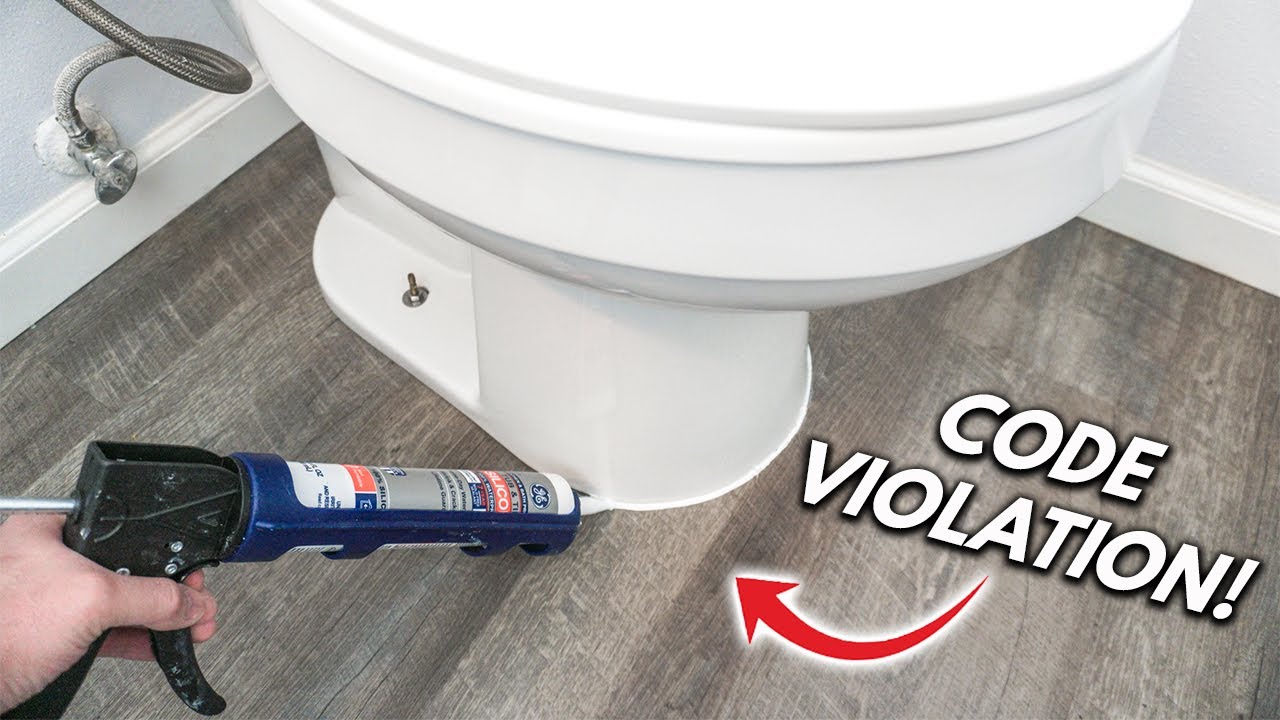Yes, you should caulk around a toilet base. Caulking prevents water damage and secures the toilet.
It also keeps out odors and pests. Installing a toilet might seem straightforward. Yet, small details like caulking can make a big difference. Some homeowners wonder if caulking is necessary. Without it, water can seep under the toilet. This might lead to mold or mildew.
A solid seal keeps your bathroom cleaner. It also enhances the toilet’s stability. Plus, it prevents unpleasant smells from escaping. Pests, like ants, can’t sneak in through gaps. Caulking is a simple task. It offers long-term benefits. Yet, many overlook its importance. So, should you caulk around a toilet base? Absolutely. It’s a small step that provides big rewards. Keep reading to learn more about how to do it right.

Credit: www.reddit.com
Caulking Basics
Caulking is a process using a sealant to close gaps. It stops water and air from getting through. Caulk is often rubbery or silicone. It helps keep your home safe and dry.
Caulking is used around windows and doors. It keeps out drafts and bugs. Another place is the bathroom. Caulk around sinks and bathtubs prevents leaks. It is also used in the kitchen. Caulking keeps food areas clean and sealed.

Credit: waypointinspection.com
Toilet Installation Essentials
The standard installation process is easy to follow. First, place the toilet bowl on the flange. Ensure it sits evenly. Use bolts to secure the bowl to the floor. Tighten the nuts carefully. Don’t over-tighten. It can crack the porcelain. Attach the toilet tank next. Ensure it fits snugly on the bowl. Fasten it with bolts. Again, avoid over-tightening. Connect the water supply. Turn on the water to check for leaks. If all is well, your toilet is ready for use.
Caulk plays an important role in toilet installation. It seals the base of the toilet. This prevents water from seeping underneath. It also helps to keep the toilet stable. Caulking around the base is easy. Apply a thin bead of caulk. Use a caulking gun for this. Smooth it with your finger for a neat finish. Ensure there’s no gap between the floor and toilet. This keeps the bathroom clean and dry.
Benefits Of Caulking Toilet Base
Caulking around the toilet base helps stop water leaks. It keeps water from going under the toilet. Water damage can ruin floors and cause mold. Mold is bad for health. Wet floors can become weak and break. Caulking makes sure the water stays where it should. Clean and dry floors stay strong.
Caulking adds strength to the toilet base. It keeps the toilet from moving. Toilets can wobble if not stable. Wobbly toilets can leak water. Stability is important for safety. A stable toilet lasts longer. Caulking helps the toilet stay put. It gives extra support. Secure toilets work better and feel safe.
Potential Drawbacks
Caulking around a toilet base may trap moisture, potentially causing hidden leaks or mold growth. It can make it challenging to detect early signs of water damage. Removing or replacing the caulk can be difficult, requiring time and effort.
Trapped Moisture Risks
Caulking around the toilet base might trap moisture. This is a big concern. Moisture can make the floor rot over time. It can also make the bathroom smell bad. This smell is hard to remove. Sometimes, mold grows in trapped moisture. Mold is not good for health. It can cause allergies and breathing problems.
Hidden Leaks Concerns
Caulking can also hide leaks. Leaks might go unnoticed for a long time. This can cause bigger problems later. Water can damage the floor and walls. This might cost a lot to fix. Hidden leaks can also make the water bill higher. It’s important to check for leaks often. Fix leaks quickly to avoid damage.
Expert Opinions
Plumbers often suggest caulking the toilet base. It helps keep the toilet stable. Caulking can prevent water leaks. Leaks can damage floors. Some say caulking looks tidy and clean. But others think it hides problems. A hidden leak can cause big issues. It’s important to check for leaks often.
Industry experts say to use silicone caulk. It’s flexible and lasts long. Choose a color that matches the bathroom. Clean the area before caulking. Apply a thin layer around the base. Make sure to leave a small gap. This gap helps spot leaks. Always follow the caulk tube instructions.
Choosing The Right Caulk
Caulk comes in many types. Silicone caulk is very flexible. It lasts a long time. Acrylic latex caulk is easy to clean. It is also paintable. Butyl rubber caulk is waterproof. It seals well in wet places. Each caulk type has its own use. Choosing the right one is key.
Look at your bathroom needs. Moisture can make caulk wear out fast. Temperature changes can crack caulk. Think about the surface too. Some caulks stick better on tile. Others are good for wood. Choose wisely. This keeps your toilet base safe.
Diy Caulking Tips
Start by cleaning the area around the toilet. Remove any old caulk using a scraper. Ensure the surface is dry and dust-free. Choose the right caulk for bathrooms. Silicone caulk is best for wet areas. Gather all tools needed. You will need a caulk gun and a damp cloth. Open a window for ventilation. This prevents strong smells in the room. Lay a towel on the floor to catch any spills.
Cut the tip of the caulk tube. The hole should be small. This gives you control over the flow. Load the tube into the caulk gun. Start from one side of the toilet base. Move slowly to the other side. Use even pressure on the gun. Ensure the caulk fills any gaps. Smooth the caulk with a damp finger. This removes any bumps. Let the caulk dry for 24 hours. Do not use the toilet during this time.
Maintenance And Inspection
Toilets need care to work well. Regular checks are important. Look for cracks or leaks. These are signs of problems. Water around the base is a red flag. It can cause damage to floors. A clean, dry base is a good sign. Keep a routine for inspection. It saves money and trouble.
Caulking can wear out. Look for cracks or peeling. These are signs of failure. Caulk should be smooth and tight. Gaps mean water can leak. Soft caulk is also a bad sign. It should be firm. Replace it when you see these signs. This keeps your toilet safe.

Credit: www.homepro-inspection.com
Frequently Asked Questions
Should A Toilet Be Caulked Around The Base?
Yes, caulking a toilet base is recommended. It prevents water leaks, stops odor, and secures the toilet in place. Use waterproof silicone caulk for best results. Ensure the area is clean before applying caulk to improve adhesion and longevity. Regularly check for gaps to maintain a proper seal.
Is It Better To Grout Or Caulk Around A Toilet?
Caulk is better than grout for sealing around a toilet. It provides flexibility and prevents leaks. Grout can crack due to movement. Caulk is easy to apply and clean. It ensures a watertight seal, protecting against water damage and mold growth.
What Is The Best Alternative To Caulking Around A Toilet?
Use a rubber gasket or flexible toilet seal as an alternative to caulking. They prevent leaks effectively. These options offer easy installation and create a watertight seal around the toilet base. They are durable, long-lasting, and provide a cleaner appearance compared to caulking.
How Often Does The Seal Around The Base Of A Toilet Need Replacing?
The toilet seal usually lasts around 5-10 years. Replace it when you notice leaks or unpleasant odors. Regular inspections help spot issues early. Proper maintenance ensures longer seal life and prevents water damage. Always check for signs of wear.
Conclusion
Caulking around a toilet base has its benefits. It prevents water seepage and keeps the area clean. Caulk adds a finished look. Consider the potential issues too. Trapped moisture can cause problems if there’s a leak. Choose the right caulk for bathrooms.
Make sure it’s mold-resistant and waterproof. Regular checks are important. Ensure there are no leaks before caulking. A little maintenance goes a long way. Keeps your bathroom looking neat and tidy. Decide based on your situation and needs. Proper caulking can be helpful.
But always weigh the pros and cons first.

